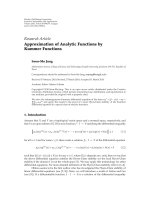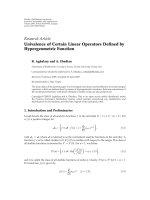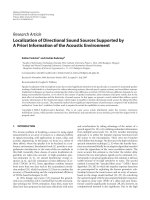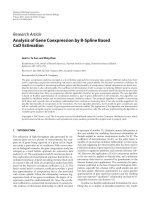Research paper WAYS OF ACCEPTING INVITATIONS BY PEOPLE OF DIFFERENT GENDERS
Bạn đang xem bản rút gọn của tài liệu. Xem và tải ngay bản đầy đủ của tài liệu tại đây (446.17 KB, 54 trang )
THE UNIVERSITY OF DANANG
COLLEGE OF FOREIGN LANGUAGES
DEPARTMENT OF ENGLISH
WAYS OF ACCEPTING INVITATIONS BY PEOPLE
OF DIFFERENT GENDERS
Supervisor
: Luu Quy Khuong
Class
: 05SPA02
Group 3
: Le Thi Hien
Nguyen Thi Luu
Phan Thi Thu Nguyet
Pham Thi Phu Thuong
Danang, 12/2008
ACKNOWLEDGEMENTS
Firstly, our group would like to express our deepest gratitude to our writing
teacher, Mr. Luu Quy Khuong, who has given us clear instructions and helpful
answers to our curious questions.
Secondly, we are also grateful to our classmates for their help and
suggestions.
Finally, we take pride in themselves because of learning how to work in
group, how to share information and how to sympathize with each other.
ABSTRACT
Our study aims at studying the ways of accepting invitations used by the
English. This study shows different ways of expressing acceptance of invitations
between male and female to help English learners use them effectively. The
research data are collected by means of English novels and stories. After selecting
samples carefully, we choose 160 samples of accepting invitation in English. With
the modest amount of informants, we do not dare to bring out the unframed
conclusion; we only make comments on our topic.
The methods that are used in this study are mainly the quantitative and
qualitative approaches. Data were analyzed with discussion and the manual
counting. Frequencies were counted and expressed as percentages. The data are
collected randomly and has been carried out in an objective manner.
OUTLINE
ACKNOWLEDGEMENTS
ABSTRACT
CONTENT
LIST OF TABLES
CHAPTER 1:
1.
2.
3.
4.
5.
6.
7.
INTRODUCTION
Rationale
Aims and objectives
Scope of the study
The research questions
Research methodology
Data collection and analysis
Research design
CHAPTER 2:
REVIEW OF LITERATURE
1. Review of previous studies
2. Theoretical background
2.1 Theory of speech act
2.2 Definition of invitations and acceptance of invitations in
English
2.3 Theory of politeness
CHAPTER 3:
FINDINGS AND DISCUSSION
1. Defining properties of acceptance of invitations
2. Classifying acceptance of invitations based on genders
3. Establishing acceptance of invitations
CHAPTER 4:
CONCLUSION
1. Summary and Conclusions
2. Limitations
3. Suggestions in developing learners’ speaking skills
4. Recommendation for further research
BIBLIOGRAPHY
REFERENCES
APPENDIX 1
APPENDIX 2
LIST OF TABLES
Table 1: Using directness and indirectness as seen from male invitees
Table 2: Using directness and indirectness as seen from female invitees
Table 3: Using directness and indirectness as seen from informants’ genders
in acceptance of invitations in English
CHAPTER 1: INTRODUCTION
1. Rationale:
Invitation is one of popular functions of language in everyday
conversation and plays an essential role in human beings’
communicative life. People use invitations for various purposes:
establishing, maintaining, improving their relationship or only for
saving face and so forth. However, invitation is just a part of
conversations or polite questions, which always look forward to
answers “yes”. To create perfect conversations, acceptance of
invitations is frequently expected. Nevertheless, acceptance of
invitations is not simple as an agreement but an art. According to
sexes, people have their own different ways of expressing
acceptance of invitations. What are therefore properties of
acceptance of invitations? Temporarily, what are the differences in
accepting invitations between male and female? In an attempt to
answer these questions, this research paper concentrates on studying
properties of acceptance of invitations as well as their
socioparagmatic functions. In addition, to find the differences in
making acceptance of invitation among genders, a comparison
between female and male acceptance of invitations is carried out.
We hope that our research named “Ways of accepting invitations by
people of different genders in English” will make a worthy
contribution to the development of English learners’ speaking skills,
especially in situations relating to accepting invitation.
2. Aims and objectives:
-
Aim:
To help English learners distinguish the different ways of accepting
invitations in English.
To help English learners realize the differences in accepting invitations
of two genders in English.
Objectives:
-
To present properties of acceptance in English conversation.
To classify acceptance of invitations.
To find out the differences in accepting invitations of different genders
in English.
3. Scope of the study:
Because of the limited ability and time, the study just focuses on ways
of accepting invitations of different genders in English stories and
novels, not daily conversation.
4. The research questions:
1. What are properties of acceptance of invitations?
2. What are differences in ways of accepting invitations between
male and female?
5. Research methodology:
The first step _ collecting materials and data: concepts, definitions,
viewpoints and samples are collected from a lot of kinds of books,
novels and stories.
The second step_ analyzing data: collected samples of acceptance of
invitations are analyzed and classified.
The third step_ discussing problems: differences in making
acceptance of invitation are discussed.
6. Data collection and analysis:
This study based on the materials, which are collected from many
sources. We carried out looking for all the samples in a long time from
novels, short stories in books and on websites. It takes the research
group less time to gather the information. Then, 160 samples are
analyzed and interpreted in the light of research objectives. The data
will be analyzed quantitatively and qualitatively to show the difference
in accepting invitations of two genders in English.
7. Research design:
Our study is firstly based on quantitative method to analyze and
classify acceptance of invitations. Secondly, comparison method is used
to find out differences in direct and indirect acceptance of invitation
CHAPTER 2: REVIEW OF LITERATURE
1. Review of previous study:
In the past, there were some valuable materials and writing related to
invitations in English. These studies provide a body of information which
will be of interest to us who work in the fields of acceptance of invitations
in English. Here is a description of what was done in the past by the writers
in English and Vietnamese.
+ The study of Chu Thi Thanh Tam (1995) [1] was a first
experiment to put the aims, methods, strategies of the conversational
research in Western linguistics into the conversational research in
Vietnamese. The paper gives us a specific definition of inviting act.
+ In the paper of Truong Thi Anh Tuyet (2003) [2], she discussed
caus es of Cross-Cultural Pragmatic Failure of Invitations in English and
Vietnamese. The study has well-done tables and figures that we can have a
look at and consult.
+ In the study of Luu Quy Khuong (2005) [3], he investigates
indirect acceptance of invitations in English and Vietnamese to enhance the
effectiveness of teaching, learning and translating this kind of speech act.
The research provides us with a significant definition of acceptance of
invitation.
+ In the research of Do Thi Chau Loan (2003) [4], she disputes
similarities and differences in making a genuine invitation in conversations
between English and Vietnamese culture. The paper supplies us for an
obvious outline and helpful theory of speech act so that we can perfect our
research.
In conclusion, each of these studies above has it own advantages as
well as certain limitations. However, what we can learn from these studies
is considerable. They are all theories of invitations, acceptances and refusal.
Thanks to them, we have general ideas about acceptance - the topic of this
research proposal.
2. Theoretical background:
2.1 Theory of speech act:
2.1.1 The notion of speech acts:
When a person utters a sequence of words, the speakers are often trying
to achieve some effects with those words; an effect which in some cases
have been might accomplished by an alternative action.
According to Sinclair and Coulthar, speech act is an utterance described
in terms of its function. In other words, speech acts are simply things
people do through language.
Bach in Routledge Encyclopedia of Philosophy Entry stated that speech
acts, in general, are acts of communication. To communicate is to
express a certain attitude, and the type of speech act being performed
corresponds to the type of attitude being expressed.
Learners of all languages tend to have difficulties understanding the
intended meaning communicated by a speech act, or producing a speech
act using appropriate language and manner in the language being
learned. Learning and understanding speech act can help learners to
improve their performance of speech acts and thus their interaction with
native speakers.
-
2.1.2 Types of Speech Acts:
According to Bach and Harnish, there are four major categories of
communicative illocutionary acts:
Constatives
Directives
Commissives
Acknowledgements
Basing on the classification of speech acts of Bach and Harnish and
Searle, speech act of accepting invitations belongs to
acknowledgements. According to them, acknowledgements are
apologizing, condoling, congratulating, greeting, thanking and
accepting.
2.1.3 Direct, Indirect and Non-literal Speech Acts:
According to Austin (1969) [5], the content of an illocutionary act (what
is said) is not always determined by what is meant by the sentence.
Moreover, what is said does not determine the illocutionary act(s) being
performed. We can perform a speech act directly or indirectly, by way
of performing another speech act, literally or non-literally, depending on
how we are using our words and explicitly or inexplicitly, depending on
whether we fully spell out what we mean.
Direct and indirect speech acts concern the relation between the
utterance and the speech act thereby performed. Direct speech acts are
the acts are expressed overtly by the most obvious linguistic means.
Direct speech acts have the same illocutionary force as the literal
reading of the sentence (no hidden intension). Indirect speech acts are
ones possess the syntactic structure more usually associated with
another acts. In indirect speech acts, the intended meaning is not the
same as its literal meaning. In the case of non-literal utterances, we do
not mean what our words mean but something else instead. With nonliterality, the illocutionary act we are performing is not the one that
would be predicted just from the meanings of the words being used.
Occasionally, utterances are both non-literal and indirect.
Indirect speech acts are considered to be more polite ways of
performing certain speech act. Indirect speech acts are generally
associated with greater politeness in English than direct speech acts.
(Yule) [9]
2.2 Definition of invitations and acceptance of invitations in English:
Inviting act is one of the acts that express directive attitude politely.
Invitation can show the speakers’ different levels of politeness. It is a
polite utterance, which urges someone to work out. This act is benefit to
the speaker and the hearer. Invitation is an utterance that presents
friendly, polite, honorable, hospitable attitude of the speaker.
Acceptance, according to Oxford Advanced Learner’s Dictionary [10] is
the act of accepting a gift, an invitation, an offer, etc.
2.3 Theory of politeness:
2.2.1 Face:
2.2.1.1 Face – Only view:
According to Kasper (1997) [7], face is considered as the public selfimage that every member wants to claim for himself (i.e. face as social –
psychological notion with emphasis on individuals’ self-generated
protection of their persona). In this notion of face, politeness is seen as
an activity serving to enhance, maintain, or to protect the face (Brown &
Levinson, 1978, 1987) [6].
2.2.1.2 Face and Place view:
Face is seen as a public rather than personal property, on loan from
society rather than an unalienable possession and a negotiable outcome
of social interaction (Goffman: 1967, Aston: 1988).
2.2.1.3 Positive Face:
Positive face is people’s want that their goals, possessions, and
achievements be ratified, understood, approved of, a liked, or admired
(Kasper, 1997). According to Goffman (1967), positive face is the want
to be thought of as a desirable human being. Brown and Levinson
(1987) state that positive face refer to the positive self-image that people
have and want to be appreciated and approved of by at least some
people.
2.2.1.4 Negative Face:
According to Goffman (1967), negative face is the want not to be
imposed upon by others. Kasper (1997) stated that negative face is when
we do not want others taking advantage of us by threatening our face.
Brown and Levinson define negative face as basic claim to territories,
personal preserves, and rights to non-distraction- i.e. freedom of action
and freedom from imposition.
2.2.2 Face – Saving:
Face saving (or saving face) refers to maintaining a good self-image.
Goffman claims that both speakers and hearers have certain amount of
face to maintain in any conversation. Therefore, each participant not
only establishes his own face but also secures the co-participant’s face.
In fact, people in interaction try to maintain the face of the others, not
just of themselves.
CHAPTER 3: FINDINGS AND DISCUSSION
1. Defining properties of acceptance of invitations:
In order to achieve success in making acceptance of invitations, it is
necessary to master characteristics of accepting invitations. In setting these
properties, some dialogues of invitations and acceptance of invitations are
used as illustrative examples.
(1) Koenigsman said, shuffling to the stove: “You want coffee?”
Mezivosky: “Please.”
[9:141]
(2) The man smiled: “Would you like to look round the house while you’re
here?
Mr. Hollins said: “Good idea. Thank you.”
[7:33]
Two underlined sentences in two above samples are viewed as
acceptance of invitations because they include properties of acceptance of
invitations: directness and indirectness, definiteness and politeness.
1.1 Directness and Indirectness:
1.1.1 Directness:
Direct acceptance is the way people accept the invitation without
hidden intension. It is expressed overtly by the most obvious linguistic
means such as “yes, yeah, ok, all right…”or “I accept…”
(3) Holmes: “A drink, Inspectator?”
Lestrade: “Yes, please, Mr. Holmes…”
[15:20]
(4) Presently Wilkins entered. “Shall I serve your dinner, sir?”
“Yes, Wilkins.” Professor Yarborough replied.
[4:56]
1.1.2 Indirectness:
Indirect acceptance is the way people accept the invitation by using
some words or phrases to show their acceptance such as “I’d love to, That
sounds nice/ lovely/ interesting,…”Through the context, the inviter can
understand the acceptance of the speaker.
(5) "Champagne?" she asked, lifting questioning eyes to his.
"It seemed appropriate for such a special occasion," Michael said.
[1:1026]
(6) Martha: “Let’s go up to the Stone.”
William: “Good idea.”
[44:30]
1.2 Definiteness:
Definiteness is the second property of acceptance of invitations and the
very important property that an acceptance of invitations should have.
In fact, in accepting an invitation, the day and hour must be repeated, so
that in case of mistake it may be corrected and prevent invitee from
arriving on a day when he or she is not expected such as “What time?”
“When exactly?” “Which day?” etc. In addition, in order to lessen
embarrassment of invitees if they are sometimes absent-minded,
repetition of the place may also be considered necessary such as
“Where exactly?” In general, definiteness is an essential property in a
genuine acceptance of invitation.
(7) He nodded with satisfaction. "Good, then you will not object to going to
the zoo with me tomorrow, will you?"
"Okay," she feigned. "What time?" "I will come for you at ten o'clock
in the morning."
[13:36]
(8) "Hi," he said. "Shall we get going then?"
"Oh yes," she said happily. "Where is the party?"
[2:206]
1.3 Politeness:
Politeness is also a significant element in accepting invitations. It helps us
to communicate successfully and effectively. Normally, when people are
invited, they always wish to show their interests and gratefulness to
inviters by using facial expressions or some structures as follows: I’d like
that very much, That would be very nice, I’d love to…
(9) Sue Ellen said to Tracy, "Warden Brannigan and I would like it very
much if you moved into the cottage. We have a spare bedroom in back.
You could take care of Amy full-time."
"Thank you," Tracy said gratefully. "I would like that."
[30:74]
(10) "Want some coffee?" Donna volunteered. "You look as though you
haven't been to bed since Friday.
Katie managed a wan smile in reply to Donna's banter. "I'd love some
coffee."
[13:141]
In conclusion, acceptance of invitations often contains three above
described properties: directness and indirectness, definiteness, politeness.
However, directness and indirectness are the main property of accepting
invitations.
2. Classifying acceptance of invitations based on genders:
It is significant to divide acceptance of invitations into identified groups
to find ways of accepting invitations successfully. In this study, we carry out
to classify ways of accepting invitations based on genders and illustrate them
with collected samples.
2.1 Ways of accepting invitations by male:
Ways of accepting invitations by male can be divided into two small
types: male inviter and female inviter.
2.1.1 Male inviters:
When male invitees accept invitations from male inviters, acceptances tend
to be direct. Moreover, English people usually get into the point and avoid
going around. Hence, answers of the male invitees are often clear. Below are
some illustrative samples:
(11) “Come on, Joe,” said Harry’s voice. “Nobody will bother it here.”
“Right,” Joe answered.
[4:258]
(12) Sampson met me outside one of the dilapidated row houses, and we
went in together.
"Just like bad old times," John said, shaking his head. "That why you're
here, Dragonslayer? Are you nostalgic for the old days? Want to come back
to the Washington PD?"
I nodded and gestured around. "Yeah. I missed this. Bad homicide scenes
in the middle of the night."
[6:219]
(13) 'Come whenever you like, we shall be glad,' called he.
'Thank you very much,' called he.
[13:1128]
In three above samples, the male invitees give direct acceptances by using
such words or phrases as “right”, “yeah”, “thank you very much”. These
samples not only approve straight and strong characteristics of men but also
agree with our opinion.
However, male English people sometimes use indirect acceptances of
invitations. In stead of saying the above direct acceptances, they give positive
comments such as “good idea”, you’re right”, etc or show their interest. Here
are two typical examples:
(14) The man smiled: “But would you like to look round the house while
you’re here?
Mr Hollins said: “Good idea. Thank you.”
[7:33]
(15) The man in the brown hat said: “Let’s go down to the restaurant, eh? I
need a drink too.”
Bill laughed: “You’re right. It’s thirsty work, telling stories.”
[8:9]
In conclusion, although male invitees occasionally accept invitations of
men indirectly in some special situations, direct acceptance of invitations is
still a general trend of men.
2.1.2 Female inviters:
That men have a tendency to accept invitations directly is no longer a
controversial problem. In fact, male invitees not only give direct acceptance
to male inviters but also female ones. The following samples will approve
that.
(16) Jackie: “Would you like some sandwiches and coffee, Inspector?”
Inspector Walsh: “Ah! Yes, please!”. “I would like sandwiches and
coffee very much.”
[45:23]
(17) Shrader was on his cell phone, so Leigh spoke to Littleton. "Thank you
for being here, and for… everything. Would you like some tea or coffee?"
she added. "I'll have a cup with you."
[1:328]
"Thanks, coffee would be great," Detective Littleton replied,
(18) She said, “Sit down and have a drink”.
Howard’s face went red again. He gave a shy little laugh. “Oh, er…thank
you,” he said
[37:4]
(19) 'Shall we go?' she said.
'Yes,' he answered.
[30:207]
In four above samples, in spite of female inviters, male invitees still use
direct acceptance such as “al right”, “thanks”, “yes”, etc.
Nevertheless, to some extent, female inviters have an influence on ways
of accepting invitations of men. This will be illustrated by following sample.
(20) "Champagne?" she asked, lifting questioning eyes to his. [1:1026]
"It seemed appropriate for such a special occasion," Michael said.
In this sample, the male inviter does not use a statement of accepting but
give a positive regard together with good facial expression.
In conclusion, despite male or female inviters, direct acceptance of
invitation is still a major trend of male invitees. Below is a statistical table of
ways of accepting invitations by male invitees.
Table 1: Using directness and indirectness as seen from male invitees
Gender
Strategies
Male – Male
Female - Male
No
%
No
%
Directness
22
66,7
31
70,5
Indirectness
11
33,3
13
29,5
Total
33
44
In this table, 77 acceptances of male invitees are divided into two groups:
33 to male inviters and 44 to female ones. In 33 acceptances of male invitees
to male inviters, there are 22 persons to give direct acceptances and make up
66, 7%; 11 remaining persons use indirect acceptances and get 33,3 %. In 44
acceptances of male invitees to female inviters, there are 31 persons to agree
invitations directly and take 70,5 %; and 13 persons only accept invitations
indirectly, make up 29,5 %. Based on above analysis and statistical table, we
cannot defy that men like to accept invitations directly.
2.2 Ways of accepting invitations by female:
Female, in general, is said to be beautiful, gentle, and profound.
Therefore, in ways of accepting invitations, women are usually thought to
give indirect acceptance. However, this is not always true to any women,
especially to English women. There are two small types in ways of accepting
invitations by female: female inviter and male inviter.
2.2.1 Female inviters:
When female people accept invitations of female inviters, they have a
tendency to give direct acceptance. Below are some illustrative samples:
(21) The nurse smiled at Jane: “Would you like a cup of tea, miss?”
Jane said: “Yes, please.”
[36:8]
(22) Shall we get to business?" Aringarosa said.
"Of course," the secretariat said.
[31:129]
(24) “I think," Whitney Westmoreland said, "Oh—and, welcome to the
family. I—I've always wanted a sister!"
[33:193]
Sherry: "Thank you."
In three above samples, female invitees respond invitations of female
inviters directly. For example, in the first sample, when the nurse invites
Jane, she gets into the point to answer by using “yes, please”. The second and
the third are the same as the first, just using “of course” or “thank you”.
However, in certain situations, they use indirect acceptances to show their
interest and polite attitude. Two following samples will illustrate this.
(25) Nessa asked: “Will you come, then?”
Jo said: “Please. I’d like to very much.”
[32:7]
(26) "Want some coffee?" Donna volunteered. "You look as though you
haven't been to bed since Friday.
Katie managed a wan smile in reply to Donna's banter. "I'd love some
coffee."
[13:141]
In two above samples, instead of using direct acceptance, they use “I’d
like to very much” in sample 45 and “I'd love some coffee” in sample 48.
In conclusion, female invitees use both direct and indirect acceptances
according to every specific situation.
2.2.2 Male inviters:
In fact, women are usually profound, soft and sensitive, especially
when they stand in front of the opposite sex. Hence, male inviters, of
course, have a considerable influence on ways of accepting invitations of
female invitees. Apparently, women tend to accept invitations indirectly.
Here are a few typical samples:
(27) Archie said: “Will you come to the concert in Exeter with me, Agatha?
We can go to the Redcliffe Hotel for tea after the concert.”
Agatha said: “I’d love to.”
[46:10+11]
(28) A few minutes later he telephoned her from his room. "How would you
like to spend tomorrow with me in Segovia? It's a fascinating old city just a
few hours outside of Madrid."
"It sounds wonderful. Thanks for a lovely evening," Tracy. said. "Good
night, Jeff.
[30:271]
(29) Drew said: “Can I buy you a pizza or not? What do you say?”
Karen smiled: “I never miss a free meal.”
[60:21]
In three above samples, we can observe the relationship between
inviters and invitees. They are either trying to understand each other or
falling in love with each other. Thus, language used in accepting invitations
by female invitees is selective. The girls give indirect acceptances, for
examples, “I’d love to”, “It sounds wonderful”, “I never miss a free meal”.
Nevertheless, it is not always true for women to use indirect
acceptances. According to the relationship between inviters and invitees,
women sometimes or, in certain circumstance, often accept invitations
directly. These following samples will make it clear.
(30) Drew said: “Poor Karen. You look very tired. Let’s go home, have a
beer and listen to some music. Forget the factory for one evening.”
Karen said: “Ok. What about a pizza at our favorite restaurant?” [60:21]
(31) Mrs. Stanhope held out her hand. "My dear, so good of you to join us.
We've asked Charles to give us a few minutes alone with you. You don't
mind?"
"Of course she doesn't mind," Charles's father declared. "Sit down... Tracy,
isn't it?"
"Yes, sir."
[30:9]
In two above samples, female invitees utter direct acceptance of
invitations such as “Ok”, “Yes, sir”. In the second sample, because the
inviter is older than the invitee, the girl uses simple language to make him
understand.
In conclusion, like any women, female English invitees also have a
tendency to accept invitations of people of the opposite sex indirectly
although in some cases, they use direct acceptance of invitations.
Table 2: Using directness and indirectness as seen from female invitees
Gender
Strategies
Female – Female
Male - Female
No
%
No
%
Directness
8
53,3
39
57,4
Indirectness
7
46,7
29
42,6
Total
15
68
In this table, 38 acceptances of female invitees are divided into two
groups: 15 to female inviters and 68 to male ones. In 15 acceptances of
female invitees to female inviters, there are 8 persons to give direct
acceptances and make up 53,5%; 7 remaining persons use indirect
acceptances and get 46,7 %. In 68 acceptances of female invitees to male
inviters, there are 39 persons to agree invitations directly and take 57,4 %;
and 29 persons only accept invitations indirectly, make up 42,6 %. Based
on above analysis and statistical table, female English invitees accept
invitations both directly and indirectly. Below is a statistical table of
strategies of accepting invitations by male and female
Table 3: Using directness and indirectness as seen from informants’
genders in acceptance of invitations in English
Gender
Strategies
Male
Female
No
%
No
%
Directness
53
68,8
47
74,7
Indirectness
24
31,2
36
25,3
Total
77
83
In 160 collected samples, 77 acceptances of male invitees are
divided into two groups: 53 direct acceptances of invitations (68,8 %)
and 24 indirect ones (31,2%). In 83 acceptances of female invitees, there
are 47 direct acceptances of invitations and make up 74,7%; 36 remaining
ones are indirect acceptances and get 25,3 %. In 68 acceptances of
female invitees to male inviters, there are 39 persons to agree invitations
directly and take 57,4 %; and 29 persons only accept invitations
indirectly, make up 42,6 %. In general, despite male or female invitees,
direct acceptance of invitations is still dominant trend.
3. Establishing acceptance of invitations:
3.1 Ways of accepting invitations:
Yes,
I’d love to.
Thank you.
I’d like to very much.
Thank
you
I’d like that very much.
much.
That sounds nice/ lovely/
interesting.
That would be very nice.
Good idea.
Fine.
very
3.2 Steps of establishing acceptance of invitations:
3.2.1 Step one:
Defining who the inviters are so that invitees can use appropriate
language of acceptance according to different genders.
3.2.2 Step two:
Designing the content of the acceptance that consists of saying
agreement, asking or repeating time and location, and showing interest, etc.
3.2.3 Making the acceptance of invitations:
While establishing the acceptance, the invitees should reveal their
attitude through the eyes, intonation, face, etc so that the inviters can
understand verbal language the invitees use.
Eye contacts:
According to Levine and Adelman (1990) in Beyond Language, eye
contact is important because insufficient or excessive eye contact
may create communication barriers. It is important in relationships
because it serves to show intimacy, attention and influence. An
English proverb says that they never trust a person who cannot look
you in the eyes.
Facial expressions:









